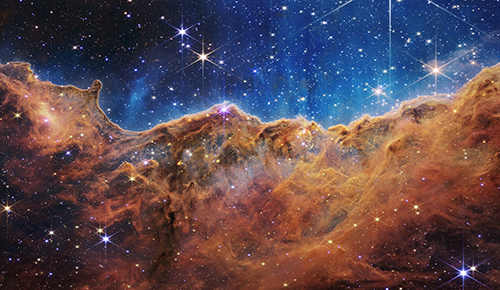 NASA released the first image from the James Webb Space Telescope. /Photography extracted from NASA |
The 31st International Astronomical Union (IAU) General Assembly ended at the Busan Exhibition & Convention Center (BEXCO) on August 11th. Not only the topics of astronomy and astronomy-related technologies, but also an announcement was made on the development and cooperation of astronomy, including seven symposiums and ten focused meetings. At the conference, it was essential to talk about the major achievements of the space telescope called “James Webb.” A main task of the James Webb Space Telescope (Webb) is to observe the first stars and galaxies created immediately after the birth of the universe.
The universe was born after the Big Bang 13.8 billion years ago. Between 200 million and 400 million years after the Big Bang, the first stars began to form. This means we should look at the universe from about 13.5 billion years ago. Webb aims to observe the stars and galaxies created during this period. About 10 billion dollars (about 12 trillion won) was spent on the Webb, which has the largest and most powerful support in human history. Webb was invented to replace the Hubble Space Telescope (Hubble), which has been on a space exploration mission for more than 30 years since 1990. Countries around the world, including the United States National Aeronautics and Space Administration (NASA), European Space Agency (ESA) and the Canadian Space Agency (CSA), have cooperated this project.
Webb, which has times as large a mirror’s condensing power as the Hubble, has infrared perspective that can investigate the inside of space dust, spectroscopic power that can finely screen the wavelength of light, and cryogenic temperatures in the minus 230 to 260 degrees Celsius range. Thanks to this, Webb has 100 times better observation ability than the Hubble. Since the speed of light is constant in space, a star that shines at longer distances is the older star. The older means that they appeared earlier. This is the reason why if we find a further star, we could move closer to search for the beginning of the universe. The universe has been expanding at an alarming speed since the Big Bang, which was 13.8 billion years ago, even at this moment. As the universe expands, the light from the first stars and galaxies must travel a long distance to reach the Earth. In the meantime, the type of light changes. It moves from visible light with short wavelengths to infrared light with long wavelengths. This shows that we should observe infrared rays, not visible rays.
We generally understand how the universe has gone through since its birth. This is a tremendous achievement of modern science within only about 100 years. However, it is not yet known how the first stars and galaxies were made or what they looked like. If Webb observes the first stars and galaxies, we will have clues to solve the big questions that do not understand about the birth and evolution of the universe. This is important since the life of the stars, outer space, and the theory of relativity can also be measured. Less than a month after Webb began its activities, the power of these powerful tools broke the record of the “most distant galaxy” observation one after another. The past few weeks have been surreal watching Webb’s record-breaking. It is surprising to find such a distant galaxy candidate in the first set of observational data. One point is that a tiny dot in Hubble’s observation was turned into a beautifully shaped full-body galaxy on the Webb.
Before Webb appeared, the distant galaxy recognized by the astronomical community was GN-z11, which is a galaxy 400 million years after the Big Bang and was discovered in 2015 in the Ursa Major by using the Hubble. The distance from this galaxy is about 32 billion light years. However, things changed rapidly as soon as Webb started working on it. The distant galaxy in observations alone last month has already changed three times, from 300 million to 290 million years ago, and now it is 235 million years ago. The galaxy named CEERS-93316 is 35 billion light years away from Earth. 235 million years after the Big Bang is close to the time when the first galaxy is thought to have begun to form, and it is estimated to be about 135 million years after the birth of the first, the oldest star which was never shown.
The new telescope has constantly expanded the horizons of humankind. This observation is just the beginning of many important observations that will be discovered by using this amazing equipment. Amazing observations from early observational data are heralding a new revolution in astronomy. In the future, Webb will send tens of millions of amazing images. We can easily see them on NASA’s website as they are released. Meanwhile, Webb will continue its career for about ten years.

